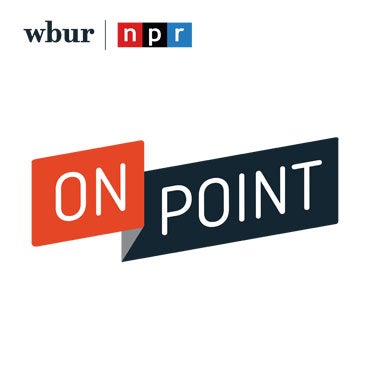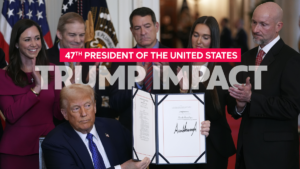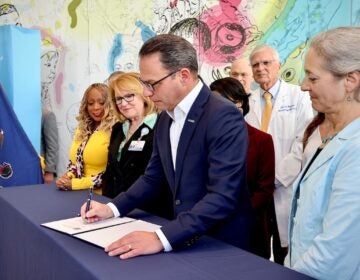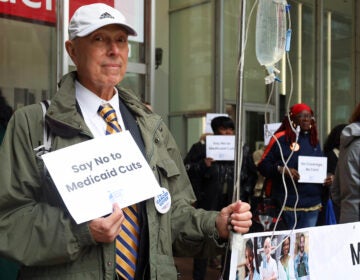Trump cuts to National Institutes of Health took more than $100M out of Pa. economy, according to local researcher
Researchers mapped out the economic impact of the federal government canceling research grants that had already been approved.
Listen 1:48
Protesters in Philadelphia gathered at City Hall to protest the Trump administration's freezes of research funding, firings of federal science agency employees at the CDC and NIH, and deletion of health data from government websites on March 7, 2025. (Kimberly Paynter/WHYY)
From Philly and the Pa. suburbs to South Jersey and Delaware, what would you like WHYY News to cover? Let us know!
The Trump administration has canceled hundreds of research grants that the National Institutes of Health had already approved. New research finds the cuts have taken a chunk out of the economies of every state and every county in the U.S., including more than $400 million and more than a thousand jobs lost from Pennsylvania, Delaware, and New Jersey.
Allie Sinclair, a cognitive neuroscientist at the University of Pennsylvania, worked with other researchers to map how the research cuts impact communities outside of the individual universities and research institutions. Her work estimates the economic impact of: lost salaries from scientists, researchers, and facilities staff; and the impact of those people spending less money in their communities. Her group used estimates based on a recent annual report from United for Medical Research, a coalition of research institutions that advocates for federal research funding, as well as Census data on commuting patterns to show where people live and work.
Sinclair said some researchers and staff may relocate to an area to work on a specific project or lab, so research institutions are major employers that attract people to communities. She added that the economic impact stands out more in places that aren’t big cities, because a university may be an important economic anchor for those regions.
“For example, the Mayo Clinic has multiple locations, which are not corresponding to big population centers, and yet they’re suffering a lot as a result of these funding cuts,” she said. “This impact is going to hit counties across the whole U.S. in red, blue, and purple states alike, and that includes both urban and rural areas.”
She said more than 50,000 people checked out the economic impact map her team made when they launched earlier this year.
“People were zooming into their local area, taking a screenshot of the losses in their county or their congressional district, and then posting that on social media, tagging community leaders, tagging local government officials, and tagging their congressional representatives to say, ‘Look what’s happening in your community.'”
Sinclair said she and her team update the data on their site regularly, and have also talked about including the impact of the Trump administration’s cuts to other federal science agencies, like the National Science Foundation and the Department of Energy.
In response to this work, a spokesperson for the National Institutes of Health sent a statement saying that “NIH is carefully reviewing all grants to assure NIH is addressing the United States chronic disease epidemic. NIH and HHS are taking actions to prioritize research that directly (affects) the health of Americans. “
The research on Sinclair’s map is useful in showing how the cuts will impact various communities across the U.S., and is comparable to how NASA presents its economic impact reports, said Andrew Fieldhouse, a macroeconomist at the Mays Business School at Texas A&M University, who specializes in studying the economic impact of government-funded research. He was not part of Sinclair’s work.
Fieldhouse added that the research on the map can’t account for how private companies may respond to research cuts — for instance, drug companies might pay more to hire scientists who used to work for universities. At the same time, he pointed out that the method on the map also doesn’t measure the medium- to long-term effects of cutting federally funded research that may take years to appear.
“A lot of what the NIH is investing in is basic research and applied research. And the fundamental knowledge gained from that work is not geographically confined,” Fieldhouse said. “If a colleague of mine at Texas A&M comes up with some really interesting biomedical breakthrough or basic science advancement, people around the entire country from Alaska to Massachusetts to Alabama will benefit from that.”
“Nothing that materializes economic drag in five to ten years is going to be super politically salient today,” Fieldhouse said. “But our collective well-being, our standards of living, having that medium-term drag on U.S. productivity growth is really important.”
His research shows that when the federal government invests in non-defense related research, it leads to more scientists graduating with degrees, more patents, more new technology, and ultimately a more productive economy.
“There’s a really big benefit, but it comes with a really long lag. We find that the productivity spillovers from government R&D spending take about seven or eight years to really start materializing in a persistent way, but then they’re highly persistent,” he said. “Our findings are pretty stark. We estimate that non-defense government R&D spending can consistently account for over 20% of all U.S. productivity growth since World War II.”
He said cutting federal funding for research will have the opposite effect, and produce a drag on the U.S. economy for years to come.

Get daily updates from WHYY News!
WHYY is your source for fact-based, in-depth journalism and information. As a nonprofit organization, we rely on financial support from readers like you. Please give today.







